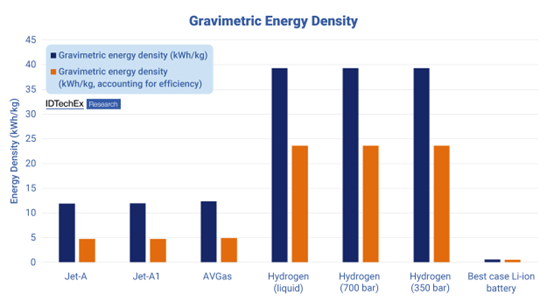
A new report from IDTechEx, “Sustainable Future Aviation 2025-2045” predicts that 24% of aircraft sales will be battery electric in 2045 and compares the relatively carbon footprint of different forms or aviation hydrogen fuel.
“Hydrogen has great promise thanks to its gravimetric energy density, at 39.3kWh/kg, it is three times as energy-dense as jet fuel and more than 100 times as energy-dense as today’s lithium-ion batteries,” say the report authors. “This can be hugely exciting until its volumetric limitations are understood. Even in liquid form, hydrogen occupies nearly four times the volume of jet fuel for the same energy. The limiting factor is getting enough storage volume on the airplane to make it useful. It is also limited by the need to be cryogenically cooled to remain a liquid, or pressurized to have useful volumetric energy density as a gas. Despite these limitations, this report explains how hydrogen can be used strategically to fulfill significant air travel demand.
The key challenge for hydrogen will be balancing fuel costs with carbon credentials, say the report authors.
“Green hydrogen, from renewable water electrolysis, is the greenest, but also the most expensive way of producing hydrogen. Blue hydrogen, produced from natural gas with carbon capture and storage (CCS), is significantly cheaper but does not provide 100% CO2 removal. Conventional grey hydrogen on the other hand can be made very cheaply, and a grey hydrogen-powered fuel cell airplane would be much cheaper to fuel than jet fuel. However, grey hydrogen emits around 10 kg of CO2 for every kg of hydrogen. This report shows the expected net emissions for each hydrogen production type highlighting which can produce a benefit compared to traditional fossil fuels.”
For more information
contact research@IDTechEx.com or visit www.IDTechEx.com.

